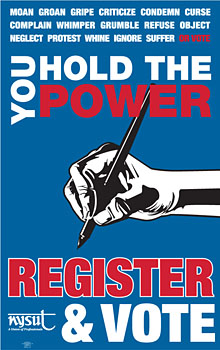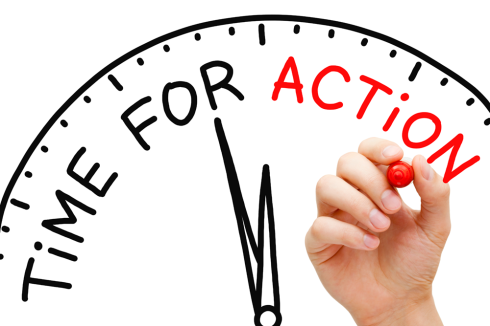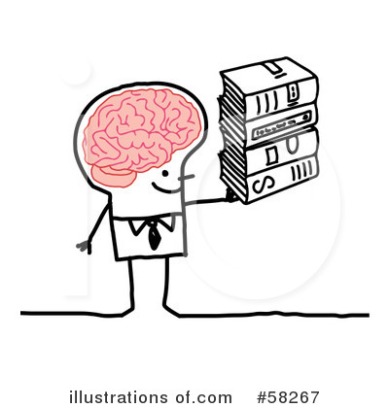September Knowledge Exchange Roundup: A Voter Resource Guide

Student staff member Hannah Wilcove provides a recap of the semester’s first Knowledge Exchange
Last week, we had our first Knowledge Exchange of the Fall 2018 semester. With the midterm elections coming up in November, our overarching theme for these Knowledge Exchanges is political and civic engagement. The topic for this Knowledge Exchange was knowing your voting rights, and over the course of the event, we talked about the history of the fight for the right to vote, some of the reasons people don’t vote (such as gerrymandering and voter suppression), and issues of accessing information. We also did an activity to demonstrate the overly-strict matching standards some states use to maintain their voter rolls, and discussed the accessibility of political engagement in the United States as well as stories of feeling encouraged or discouraged from voting. For people with family and friends that are active in politics, it can be hard to think that there are people who don’t know how to vote, but the truth is, seeking out that information can be difficult and time-consuming. From this conversation, the need for a voter resource guide was born.
Side note: This blog is meant to be a general resource, and election laws vary by state, which means it’s hard to cover all the complexities and variations. Because so many people at UMBC are from Maryland, that’s what my examples will cover, but if you want more detailed information about a specific state, I encourage you to look up your state’s name and the information you’re looking for (ex: “Virginia voter registration deadline”).
- Registration: The first step in voting in the United States is registration. Unlike some other countries, voter registration in the U.S. is not automatic. So if you’re not registered to vote and you would like to be, take 2 minutes to register here. Make sure to do that before your state’s voter registration deadline, and if it’s passed, check whether or not they have same-day registration (you can do all of that here). In case you didn’t know, Maryland’s voter registration deadline is October 16th, 2018 at 9:00 pm. One thing we focused on in our conversation was voter suppression and the fact that many people–including active voters–have been purged from the voter rolls in recent elections. If that’s something you’re concerned about, you can take 30 seconds to double check your registration status here.

- Voting Method: So you’ve got your registration all worked out; now it’s time to figure out how you’re going to vote. Depending on your situation, you have a few different options. If you have some time on Election Day (Tuesday, November 6th), then you can go the traditional route: go to the polls, wait in line, and vote. However, that option won’t work for everyone. If that’s the case, fear not. Maybe you have some time before Election Day, but not on that Tuesday. If that’s the case, you should look into early voting. The details vary by state, but here is a link where you can look into which states have early voting (Maryland does), and here is a calendar that tells you when the early voting period for each state is. If that still doesn’t work, you can look into absentee ballot. With absentee ballots, you don’t have to go to the polls because you just mail in your ballot. This is a great option for people who don’t have reliable transportation, but note that there are two downsides to doing this. The first is that absentee ballots aren’t counted unless the difference in other votes is close enough to warrant it (i.e. if Candidate A is 100 votes ahead of Candidate B, and there are only 20 absentee ballots, those 20 votes won’t be counted because they won’t change the outcome), and the second is that you don’t get a sticker. Still, you shouldn’t assume that your vote won’t be counted, so if absentee voting looks like the best option for you, then check out your state’s rules for it here. Just like early voting, the deadlines around absentee ballots vary by state, so take a look here at what your state’s deadlines are.

- Action Plan: Once you’ve figured out how you’re going to vote, the next step is making an action plan. This might seem like overkill, but given the craziness that is life, an action plan can help you make sure that you don’t forget to vote or run out of time on election day. So what do you need to know? If you’re voting via absentee ballot, then you just need to make sure that you apply for your ballot and send it in by your state’s deadlines (links are in the above section). If you’re going to the polls, either during early voting or on Election Day, then there’s a little bit more to it. First, you need to figure out where your polling place is, so you can actually go there. You can use this link to find your polling place, but the most reliable method is to use your state’s board of elections website (a list of those is provided on the linked page). For early voting, there may be fewer polling locations open, but you can use this website to find out the specifics for your state and county (you just click on “early voting” under topics and your state, and voila). With these sites, you should also be able to find the specific hours that your polling place is open. Lastly, once you figure out where and when you’re voting, you just need to figure out how to get there. If you have access to a car, then that’s taken care of, but if not, have no fear. If you can’t get a ride from someone, check if your polling place is accessible by public transportation. If so, look up the schedule and make sure that there’s a time you can get there. Not the case? Not a problem. The rideshare company Lyft is offering 50% off rides to the polls on Election Day. For UMBC students, SGA is providing free transportation to early voting in six counties across the state, which you can learn more about here.

-
Research: You’re all set; you know how you’re going to vote and when, and you’re ready to head to your polling place and vote for…oh, right, you actually need to know who’s on the ballot and what they’re running for. At our Knowledge Exchange, we talked about how hard it can be to figure out all the details because, frankly, not everyone has the time to do that kind of extensive research. The good news is that there are people who have already done some of the work for you. If you need to know what district you’re in, you can use this website if you live in Maryland (just click on the button that says “who represents me” at the top right), and this one if you don’t. The League of Women Voters also has a great tool on their website where you can enter your address and see all the races on your ballot, learn about candidates’ backgrounds, and compare their answers to various questions. For all you Maryland folk reading this, The Baltimore Sun has a voter guide just for you, with comprehensive bios, questionnaires, and articles about each candidate running for elected office in our state.

-
Tell your friends! Now you’re really all set. If you want to increase the voter rate in the U.S., then one of the best ways to do so is word of mouth! As I’ve said before, it can be difficult and time-consuming to figure all this out, but now that you’re basically an expert, you can help your friends work through it. Plus, with all the links right in front of you, you don’t have to reinvent the wheel; just share this guide with your friends to make voting a little more accessible.

Further Reading:
- A video about gerrymandering that we played at the Knowledge Exchange
- An article that lists and describes 12 current methods of voter suppression (note that this article does have a clear slant, however it does a great job at explaining each method)
- A webpage by the League of Women Voters that has several articles about current efforts to combat voter suppression and increase voter turnout
Posted: October 4, 2018, 10:00 AM